Armored vehicles "Three-wheel drive" N.M. Filatov
In practice, it turned out that the Harford Putilov armored cars have an insufficiently powerful propulsion system and do not have low weight, which is why their off-road mobility leaves much to be desired. Further modernization of the equipment on the basis of the Garford 4x2 truck did not seem appropriate. Specialists of the Officer Shooting School (Oranienbaum), headed by its leader N.M. Filatov decided to continue the development of cannon armored vehicles by creating a new original chassis. In addition, at a certain stage in the development of a new project, it was decided to develop an original chassis that could be used as the basis for a new armored car.
To increase the cross-country ability, especially on rough terrain, it was required to maximally facilitate the promising armored vehicle. To this end, it was decided to reduce the dimensions of the machine to the required minimum, as well as to use a non-standard three-wheeled undercarriage. In order to reduce the weight of the whole structure, instead of the front axle, it was proposed to use a special plug with a wheel and a steering mechanism. With the right design, such mechanisms made it possible to reduce the weight of the entire machine, as well as improve maneuverability. The original chassis design led to the appearance of the corresponding project name. All new armored cars Filatov were hereinafter referred to as the "Three-wheels".
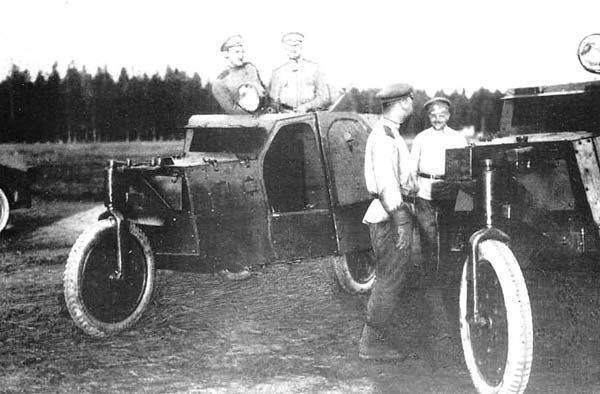
Armored "Three-wheel" of the first batch, 1916
Due to the lack of ready-made chassis with such a construction, Filatov and his colleagues had to develop the necessary car themselves. As a basis for the new three-wheeled chassis, the aggregates of the existing equipment were taken. It was planned to use ready-made bridges, suspension elements, engines and transmission units. As it turned out later, a similar approach allowed for a relatively massive mass production of equipment, using damaged machines as a source of components and assemblies.
The three-wheeled chassis, with the exception of some parts, hardly differed from other samples of a similar purpose. All its units were mounted on a rectangular frame according to the classical layout. In front of the frame was the engine connected to the gearbox, in the rear was a two-wheel drive axle with suspension on leaf springs. The middle and rear part of the chassis was proposed to give for the placement of the fighting compartment.
In the front part a special frame was fastened to the chassis, on which the front wheel fork was hinged. In the upper part of the frame was provided a swivel mechanism associated with the steering wheel in the driver's cabin. Drive on the front wheel was not provided. Thus, the chassis had a wheel formula 3x2, which is not standard for cars.
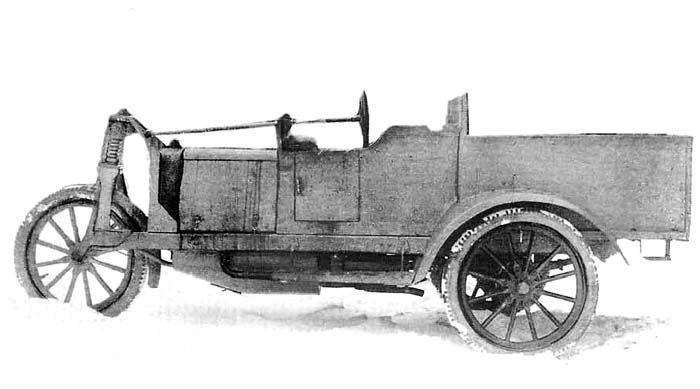
Basic three-wheeled chassis, designed specifically for new armored vehicles
On top of the chassis it was proposed to install an armored case with a new design. It was supposed to be assembled from armor plates with a thickness from 4 to 6 mm. In this case, in view of the intended method of combat use, thicker armor should have been located in the stern. Like many other armored cars of that time, Filatov's “Three Wheels” had to have a body assembled on a frame. The available technologies allowed using only such a hull structure.
Initially, Filatov and his colleagues were engaged in the creation of a cannon armored car, which could complement and then replace the existing equipment of this class. In the future, there was a proposal to develop and machine-gun version of the machine. In this case, it was possible to provide the army with armored vehicles of various types with similar characteristics and different weapons.
Two versions of the armored car were to be equipped with hulls of various shapes. In this case, the overall design and layout of the buildings was the same. Under the small hood was the engine, and the crew and weapons were located in the large feed volume. For access to the engine, hatches were provided in the side plates of the hood. For landing in the car door in the sides of the habitable volume there were two doors. In the roof of the hull, above the jobs of the driver and the commander, there was an additional hatch. To observe the road in the frontal list of the habitable compartment there was a large viewing hatch with a lid.
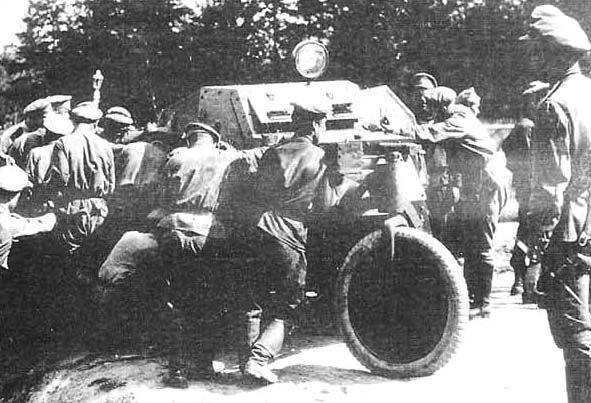
Military inspect one of the armored cars
The basic cannon armored car was supposed to receive a less high hull with a sloping stern sheet, in which there was an embrasure for the gun. Another notable feature of the gun armored car was the lack of chassis protection at the expense of the lower part of the sides. The hull box was installed on top of the chassis and did not close the chassis aggregates.
In the machine-gun version of the "Three-wheels" had the protection of the chassis, and the fighting compartment protected by sides and stern, installed vertically or at a slight angle. Armament is also proposed to mount in the stern sheet in two embrasures.
Armored cars should be equipped with petrol engines of about 20 hp. The project involved the use of various types of engines available. Thus, the authors of the project took into account the difficult situation with the finished equipment and spare parts, providing for the use of available components. In the same way it was proposed to complete the transmission and chassis.
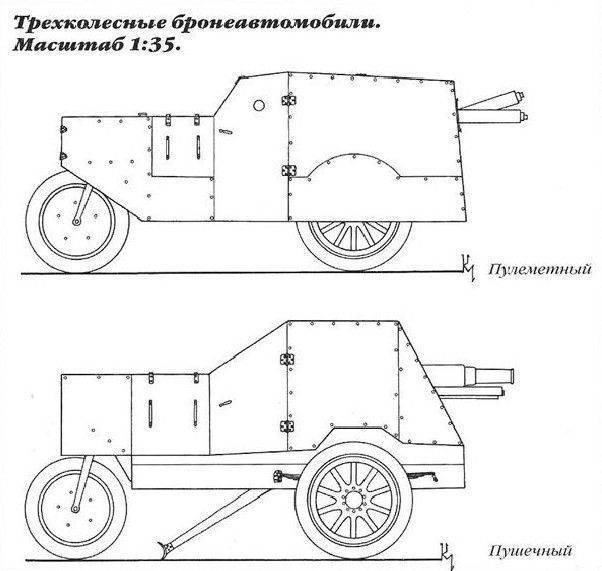
Two types of armored vehicles
The crew of the “Three Wheels” was to consist of three or four people: the driver, the commander and one or two shooters. The crew depended directly on the established weapons.
Cannon armored car designs NM Filatov was asked to equip the gun with an 76-mm anti-assault gun model 1910 year. This gun was a modified and lightened version of the 76-mm mountain cannon and was already used on domestic armored cars. In particular, the Garford-Putila cars were equipped with just such weapons. The gun carriage made it possible to perform horizontal and vertical guidance within certain sectors. Ammunition of the gun was placed in the layouts at the sides of the fighting compartment.
The three-wheeled armored car was supposed to have the smallest possible combat mass, due to which its gun version had to be equipped with some special equipment. Due to the high recoil of the gun, it was proposed to install a special opener on the bottom of the machine, which should have been lowered to the ground before firing. This detail made it possible to reduce the displacement of the armored car under the effect of recoil, and also to maintain the tip-off after the shot.
In the stern sheet of the machine gun armored carvings were provided for installing two Maxim machine guns. They had to manage two shooters. As in the case of the cannon machine, the ammunition of machine guns was located on racks at the sides of the fighting compartment.
By April, 1916, the specialists of the Officers' Infantry School built several copies of the new technology. In the course of their manufacture, components and assemblies of existing automotive equipment that was damaged and not subject to restoration were used in the most active way. This made it possible to quickly complete all the necessary work, but it affected the characteristics of the equipment. So, the cars of the first batch were equipped with engines of various models and brands. In addition, they differed power plant: armored cars equipped with engines from 16 to 24 hp. Due to the use of engines and other units of different models, all the armored vehicles of the first batch were seriously different from each other in their characteristics. Despite some differences, the machine-gun armored vehicles had a similar combat mass at the level of 1,8 t. The machine-gun armored car weighed about 2,6 t.
The first batch of armored vehicles consisted of nine machine-gun "Three-wheels" and one machine with cannon armament. April 22 built armored vehicles presented to the Commission on armored vehicles and other representatives of the military. A potential customer showed interest in the original three-wheeled vehicles, resulting in the emergence of a requirement for testing new equipment. Trials started in early May.
During the tests it was found that the cannon "Three-wheeled" has a lack of permeability. Combat weight at the level of 2,6 t was too large for confident movement on three wheels. At the same time, the machine gun armored car fully met all expectations. A light car moved along rather difficult tracks without any problems and did not get stuck on them.
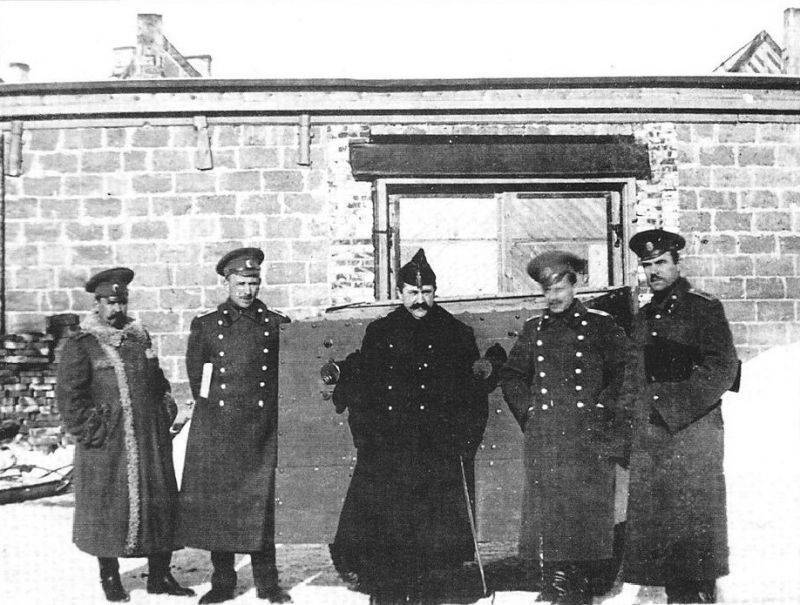
Officer of the Belgian armored division (center) and the staff of the Officer rifle school against the background of the machine-gun "Three-wheels", 1916
According to the test results, the representatives of the military department decided to order the mass production of machine-gun armored cars of the new model. In accordance with the order, Izhora plant was supposed to build two dozen such machines with machine-gun armament. Gun armored car did not put in the series. Nevertheless, the army took a single copy of such a machine and exploited it along with other equipment of the new project.
According to some data, in the course of preparation for serial production, Major General Filatov made some changes to the project. It was decided to abandon the second stern machine gun, as well as much to change the design of the hull. Due to such changes, the armored car became lighter by about 400 kg, which should have led to some increase in mobility and maneuverability.
In October, the Izhora Plant tested 1916 and handed over to the customer the first production “Three-wheel Drive” with machine guns. Until the end of the year, seven more such armored vehicles left the company’s gates. Reliable information about the future release of armored cars is missing. According to some data, all Filatov's armored cars were built in 1915-16, but other sources mention the complete fulfillment of the order by the end of 1917.
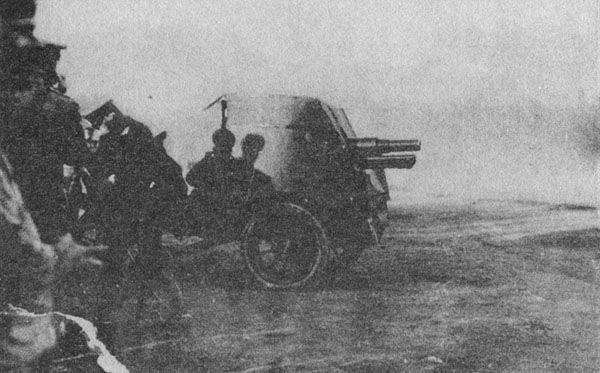
Cannon armored car during firing
Simultaneously with the launch of the production of serial machines, troop tests were launched. Four front-line technicians were supposed to check the new equipment: 1, 7, 8, and 9 armored car divisions. They were given two machine gun (1 and 7 divisions), two machine gun and one gun (8) and one machine gun (9) armored vehicles. The troop tests were carried out without complaints and, in general, confirmed the correctness of the decisions of the commission responsible for the selection of new equipment.
According to various sources, up to 1917, the 18 to 30 Tricycle armored cars were built in machine-gun and cannon configurations. Part of this technique was used by the army in combat on the German front. In general, the machines showed themselves well and were not inferior to other samples used at that time.
After the beginning of the Civil War, the armored cars of the construction of Major General Filatov went to both sides of the conflict. There is information about the use of this technique by both the Red Army and the White Guards. For example, in August 1918, three “Three-wheels” at once were sent to Baku to support the local “Red” formations. At the same time, at least one such armored car served in the auto-armor-machine-gun detachment of the Smolny guard. In the first months of 1920, he had to be sent to the front.
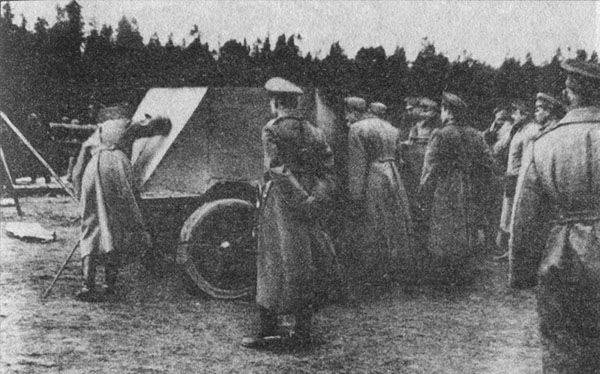
Military personnel and "Three-wheel drive" with cannon armament
Details of operation of armored cars Filatov "white" are absent. It is known that at the end of 1918, the Volunteer Army had at least one vehicle of this type. The armored car with its own name "Fiber" was listed as part of the 1-th armored car division. In April, 1919-th, this machine was in Ekaterinodar (Krasnodar), where she soon went for disassembly. In view of the wear and unsuitability to service, they dismantled armor and weapons from the car. Her further fate is unknown.
Several “Three-wheeled” armored cars survived to the end of the Civil War and for some time continued to serve in the Red Army. It is known that at the beginning of 1922, the Red Army Armor Forces Directorate had four such vehicles. The exact type of this technique is unknown, but apparently it was the most massive machine-gun armored vehicles.
Probably, most of the built armored cars of Filatov’s construction were destroyed in battle or decommissioned due to wear or damage. Only a few of these machines survived the Civil War and continued service in the Red Army. The fate of this technique is unknown. Most likely, during the First World and Civilian these machines managed to develop their own resources, after which their operation was not possible. As a result, they were disarmed, booked and disposed of. It cannot be excluded that after that some chassis could be used as automotive vehicles. However, in the end, all of the “Three Wheels” of Filatov were written off and disposed of. To this day, this technique did not live.
Based on:
http://aviarmor.net/
Baryatinsky MB, Kolomiets M.V. Armored cars of the Russian army 1906 – 1917 - M .: Technics-youth, 2000
Solyankin A. G., Pavlov M. V., Pavlov I. V., Zheltov I. G. Domestic armored vehicles. XX century. - M .: Exprint, 2002. - T. 1. 1905 – 1941
- Ryabov Kirill
- Baryatinsky MB, Kolomiets M.V. Armored cars of the Russian army 1906 – 1917, Aviarmor.net
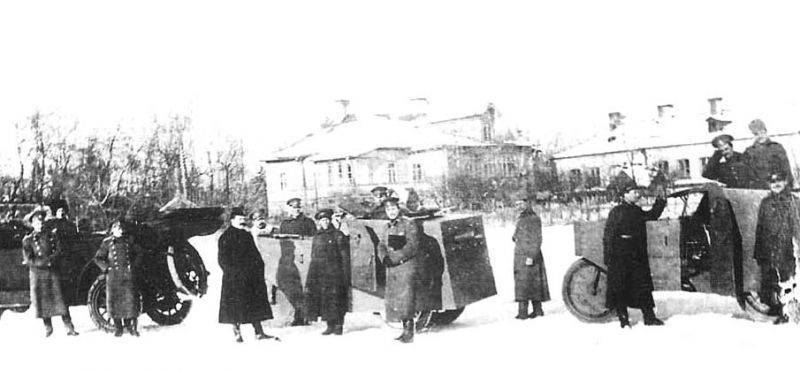
Information